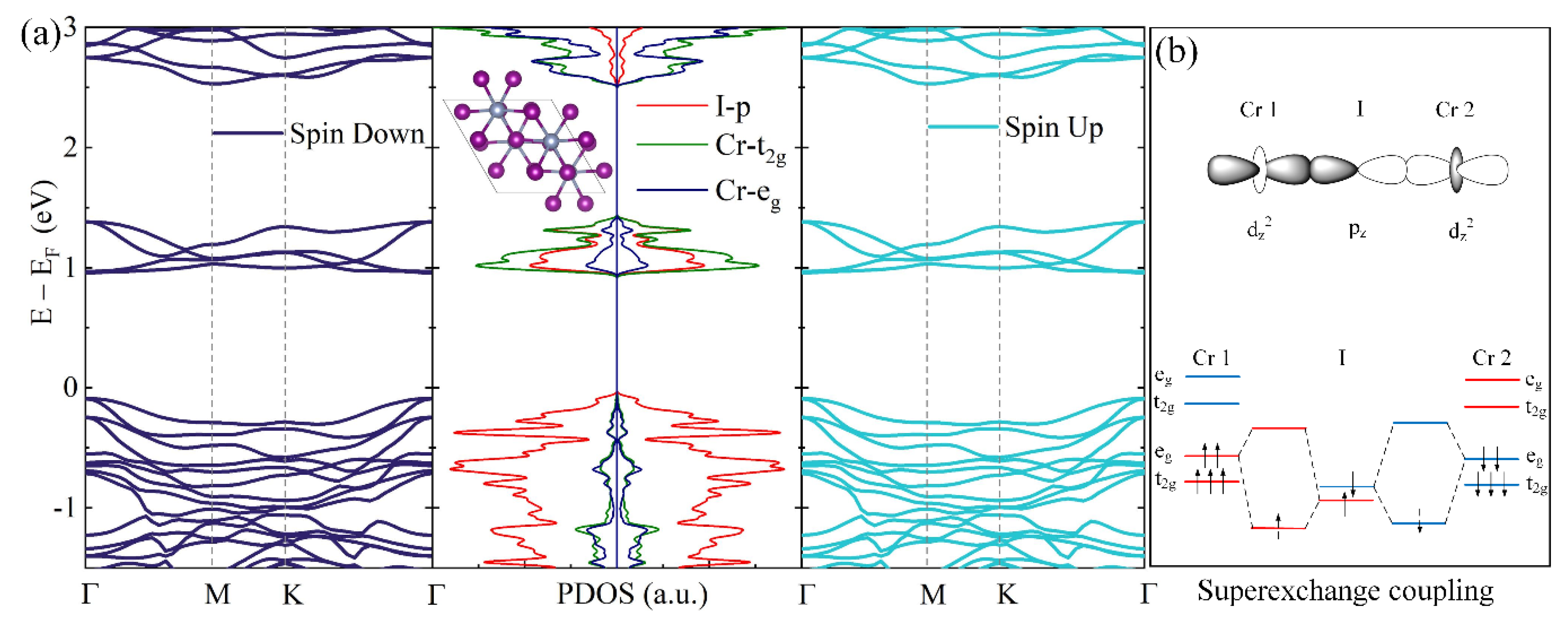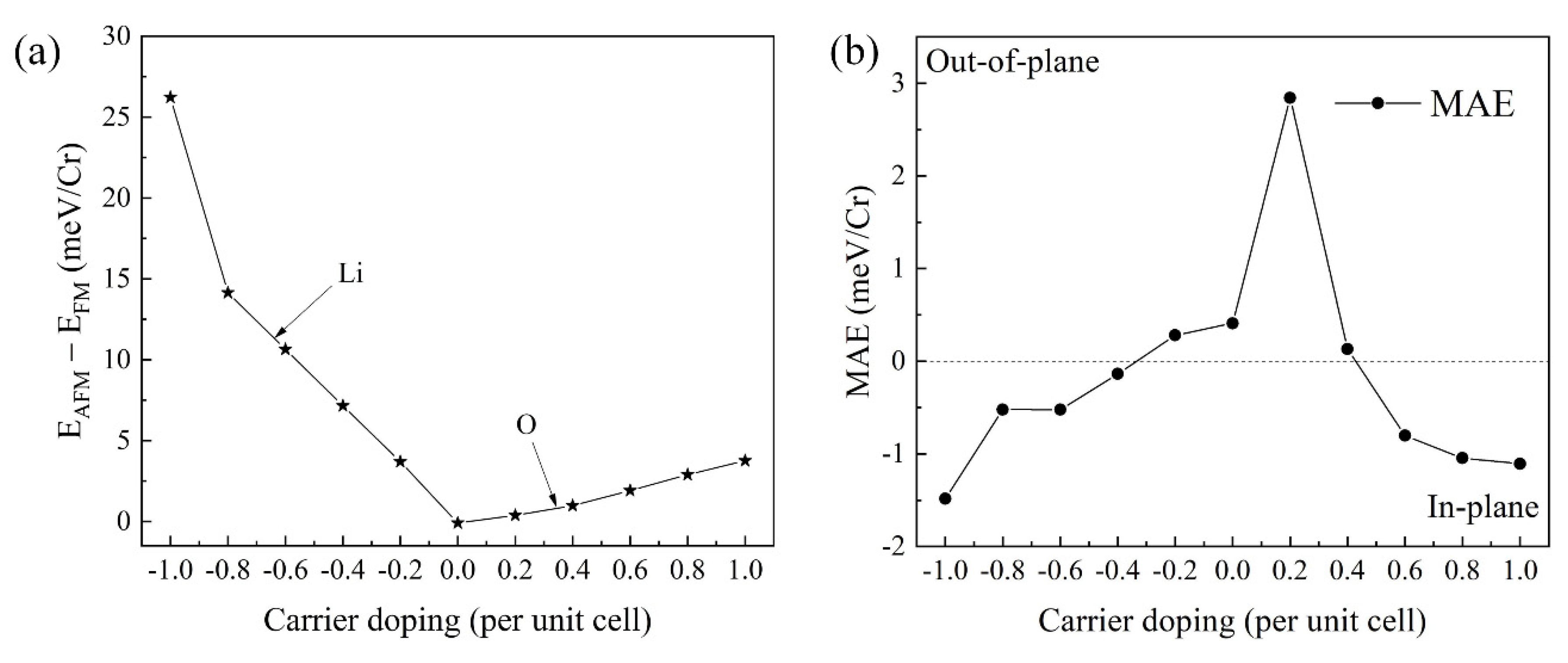Atomic Intercalation Induced Spin-Flip Transition in Bilayer CrI3
Abstract
:1. Introduction
2. Computational Methods
3. Results and Discussion
4. Conclusions
Author Contributions
Funding
Institutional Review Board Statement
Informed Consent Statement
Data Availability Statement
Conflicts of Interest
References
- McGuire, M.A.; Dixit, H.; Cooper, V.R.; Sales, B.C. Coupling of Crystal Structure and Magnetism in the Layered, Ferromagnetic Insulator CrI3. Chem. Mater. 2015, 27, 612–620. [Google Scholar] [CrossRef]
- Huang, C.; Feng, J.; Wu, F.; Ahmed, D.; Huang, B.; Xiang, H.; Deng, K.; Kan, E. Toward Intrinsic Room-Temperature Ferromagnetism in Two-Dimensional Semiconductors. J. Am. Chem. Soc. 2018, 140, 11519–11525. [Google Scholar] [CrossRef] [PubMed]
- Liu, H.; Sun, J.T.; Liu, M.; Meng, S. Screening Magnetic Two-Dimensional Atomic Crystals with Nontrivial Electronic Topology. J. Phys. Chem. Lett. 2018, 9, 6709–6715. [Google Scholar] [CrossRef] [PubMed] [Green Version]
- Deng, Y.; Yu, Y.; Song, Y.; Zhang, J.; Wang, N.Z.; Sun, Z.; Yi, Y.; Wu, Y.Z.; Wu, S.; Zhu, J.; et al. Gate-tunable room-temperature ferromagnetism in two-dimensional Fe3GeTe2. Nature 2018, 563, 94–99. [Google Scholar] [CrossRef]
- Huang, B.; Clark, G.; Navarro-Moratalla, E.; Klein, D.R.; Cheng, R.; Seyler, K.L.; Zhong, D.; Schmidgall, E.; McGuire, M.A.; Cobden, D.H.; et al. Layer-dependent ferromagnetism in a van der Waals crystal down to the monolayer limit. Nature 2017, 546, 270–273. [Google Scholar] [CrossRef] [Green Version]
- Cheng, Y.; Zhu, Z.; Mi, W.; Guo, Z.; Schwingenschlögl, U. Prediction of two-dimensional diluted magnetic semiconductors: Doped monolayer MoS2 systems. Phys. Rev. B 2013, 87, 100401. [Google Scholar] [CrossRef] [Green Version]
- Yazyev, O.V.; Helm, L. Defect-induced magnetism in graphene. Phys. Rev. B 2007, 75, 125408. [Google Scholar] [CrossRef] [Green Version]
- Li, H.; Ruan, S.; Zeng, Y.J. Intrinsic Van Der Waals Magnetic Materials from Bulk to the 2D Limit: New Frontiers of Spintronics. Adv. Mater. 2019, 31, e1900065. [Google Scholar] [CrossRef]
- Gong, C.; Li, L.; Li, Z.; Ji, H.; Stern, A.; Xia, Y.; Cao, T.; Bao, W.; Wang, C.; Wang, Y.; et al. Discovery of intrinsic ferromagnetism in two-dimensional van der Waals crystals. Nature 2017, 546, 265–269. [Google Scholar] [CrossRef] [Green Version]
- Yang, B.; Zhang, X.; Yang, H.; Han, X.; Yan, Y. Nonmetallic atoms induced magnetic anisotropy in monolayer chromium trihalides. J. Phys. Chem. C 2018, 123, 691–697. [Google Scholar] [CrossRef]
- Li, T.X.; Jiang, S.W.; Sivadas, N.; Wang, Z.F.; Xu, Y.; Weber, D.; Goldberger, J.E.; Watanabe, K.; Taniguchi, T.; Fennie, C.J.; et al. Pressure-controlled interlayer magnetism in atomically thin CrI3. Nat. Mater. 2019, 18, 1303–1308. [Google Scholar] [CrossRef] [PubMed] [Green Version]
- Song, T.; Fei, Z.; Yankowitz, M.; Lin, Z.; Jiang, Q.; Hwangbo, K.; Zhang, Q.; Sun, B.; Taniguchi, T.; Watanabe, K.; et al. Switching 2D magnetic states via pressure tuning of layer stacking. Nat. Mater. 2019, 18, 1298–1302. [Google Scholar] [CrossRef] [PubMed] [Green Version]
- Webster, L.; Yan, J.A. Strain-tunable magnetic anisotropy in monolayer CrCl3, CrBr3, and CrI3. Phys. Rev. B 2018, 98, 144411. [Google Scholar] [CrossRef] [Green Version]
- Wu, Z.; Yu, J.; Yuan, S. Strain-tunable magnetic and electronic properties of monolayer CrI3. Phys. Chem. Chem. Phys. 2019, 21, 7750–7755. [Google Scholar] [CrossRef] [PubMed] [Green Version]
- Wang, H.; Fan, F.; Zhu, S.; Wu, H. Doping enhanced ferromagnetism and induced half-metallicity in CrI3 monolayer. EPL Europhys. Lett. 2016, 114, 47001. [Google Scholar] [CrossRef]
- Jiang, S.; Li, L.; Wang, Z.; Mak, K.F.; Shan, J. Controlling magnetism in 2D CrI3 by electrostatic doping. Nat. Nanotechnol. 2018, 13, 549–553. [Google Scholar] [CrossRef] [PubMed]
- Zhang, J.; Guo, Y.; Li, P.; Wang, J.; Zhou, S.; Zhao, J.; Guo, D.; Zhong, D. Imaging Vacancy Defects in Single-Layer Chromium Triiodide. J. Phys. Chem. Lett. 2021, 12, 2199–2205. [Google Scholar] [CrossRef]
- Wang, R.; Su, Y.; Yang, G.; Zhang, J.; Zhang, S. Bipolar Doping by Intrinsic Defects and Magnetic Phase Instability in Monolayer CrI3. Chem. Mater. 2020, 32, 1545–1552. [Google Scholar] [CrossRef]
- Pizzochero, M. Atomic-scale defects in the two-dimensional ferromagnet CrI3 from first principles. J. Phys. D Appl. Phys. 2020, 53, 244003. [Google Scholar] [CrossRef] [Green Version]
- Qin, W.J.; Xu, B.; Liao, S.S.; Liu, G.; Sun, B.Z.; Wu, M.S. Flat-band splitting induced tunable magnetism in defective CrI3 monolayer. Solid State Commun. 2020, 321, 114037. [Google Scholar] [CrossRef]
- Sainbileg, B.; Batsaikhan, E.; Hayashi, M. Impact of oxygen defects on a ferromagnetic CrI3 monolayer. RSC Adv. 2020, 10, 42493–42501. [Google Scholar] [CrossRef]
- Suárez Morell, E.; León, A.; Miwa, R.H.; Vargas, P. Control of magnetism in bilayer CrI3 by an external electric field. 2D Mater. 2019, 6, 025020. [Google Scholar] [CrossRef] [Green Version]
- Ghosh, S.; Stojic, N.; Binggeli, N. Structural and magnetic response of CrI3 monolayer to electric field. Phys. B 2019, 570, 166–171. [Google Scholar] [CrossRef] [Green Version]
- Cao, X.; Lei, Z.; Huang, B.; Wei, A.; Tao, L.; Yang, Y.; Zheng, Z.; Feng, X.; Li, J.; Zhao, Y. Non-Layered Te/In2S3 Tunneling Heterojunctions with Ultrahigh Photoresponsivity and Fast Photoresponse. Small 2022, 18, 2200445. [Google Scholar] [CrossRef] [PubMed]
- Xu, Q.F.; Xie, W.Q.; Lu, Z.W.; Zhao, Y.J. Theoretical study of enhanced ferromagnetism and tunable magnetic anisotropy of monolayer CrI3 by surface adsorption. Phys. Lett. A 2020, 384, 126754. [Google Scholar] [CrossRef]
- Lu, M.; Yao, Q.S.; Li, Q.Y.; Xiao, C.Y.; Huang, C.X.; Kan, E.J. Tuning Electronic and Magnetic Properties of Two-Dimensional Ferromagnetic Semiconductor CrI3 through Adsorption of Benzene. J. Phys. Chem. C 2020, 124, 22143–22149. [Google Scholar] [CrossRef]
- Yang, Q.; Hu, X.; Shen, X.; Krasheninnikov, A.V.; Chen, Z.; Sun, L. Enhancing Ferromagnetism and Tuning Electronic Properties of CrI3 Monolayers by Adsorption of Transition-Metal Atoms. ACS Appl. Mater. Interfaces 2021, 13, 21593–21601. [Google Scholar] [CrossRef]
- Zheng, Z.J.; Ren, K.; Huang, Z.M.; Zhu, Z.Y.; Wang, K.; Shen, Z.L.; Yu, J. Remarkably improved Curie temperature for two-dimensional CrI3 by gas molecular adsorption: A DFT study. Semicond. Sci. Technol. 2021, 36, 075015. [Google Scholar] [CrossRef]
- Guo, Y.L.; Yuan, S.J.; Wang, B.; Shi, L.; Wang, J.L. Half-metallicity and enhanced ferromagnetism in Li-adsorbed ultrathin chromium triiodide. J. Mater. Chem. C 2018, 6, 5716–5720. [Google Scholar] [CrossRef]
- Li, H.; Cheng, Z.P.; He, B.G.; Zhang, W.B. Engineering the ligand states by surface functionalization: A new way to enhance the ferromagnetism of CrI3. Nanoscale 2021, 13, 4821–4827. [Google Scholar] [CrossRef]
- Zheng, F.; Zhao, J.; Liu, Z.; Li, M.; Zhou, M.; Zhang, S.; Zhang, P. Tunable spin states in the two-dimensional magnet CrI3. Nanoscale 2018, 10, 14298–14303. [Google Scholar] [CrossRef] [PubMed] [Green Version]
- Narin, P.; Kutlu, E.; Sarikavak-Lisesivdin, B.; Lisesivdin, S.B.; Ozbay, E. Electronic properties of Li-doped zigzag graphene nanoribbons. Phys. E 2016, 84, 543–547. [Google Scholar] [CrossRef]
- Xiong, F.; Wang, H.; Liu, X.; Sun, J.; Brongersma, M.; Pop, E.; Cui, Y. Li Intercalation in MoS2: In Situ Observation of Its Dynamics and Tuning Optical and Electrical Properties. Nano Lett. 2015, 15, 6777–6784. [Google Scholar] [CrossRef] [PubMed]
- Bao, W.; Wan, J.; Han, X.; Cai, X.; Zhu, H.; Kim, D.; Ma, D.; Xu, Y.; Munday, J.N.; Drew, H.D.; et al. Approaching the limits of transparency and conductivity in graphitic materials through lithium intercalation. Nat. Commun. 2014, 5, 4224. [Google Scholar] [CrossRef] [Green Version]
- Cho, J.; Losego, M.D.; Zhang, H.G.; Kim, H.; Zuo, J.; Petrov, I.; Cahill, D.G.; Braun, P.V. Electrochemically tunable thermal conductivity of lithium cobalt oxide. Nat. Commun. 2014, 5, 4035. [Google Scholar] [CrossRef] [Green Version]
- Jiang, P.; Wang, C.; Chen, D.; Zhong, Z.; Yuan, Z.; Lu, Z.; Ji, W. Stacking tunable interlayer magnetism in bilayer CrI3. Phys. Rev. B 2019, 99, 144401. [Google Scholar] [CrossRef] [Green Version]
- Jang, S.W.; Jeong, M.Y.; Yoon, H.; Ryee, S.; Han, M.J. Microscopic understanding of magnetic interactions in bilayer CrI3. Phys. Rev. Mater. 2019, 3, 031001. [Google Scholar] [CrossRef] [Green Version]
- Tang, Y.X.; Khalaf, A.J.M.; Rajagopal, K.; Pham, V.T.; Jafari, S.; Tian, Y. A new nonlinear oscillator with infinite number of coexisting hidden and self-excited attractors. Chin. Phys. B. 2018, 27, 040502. [Google Scholar] [CrossRef]
- Kresse, G.; Furthmuller, J. Efficient iterative schemes for ab initio total-energy calculations using a plane-wave basis set. Phys. Rev. B 1996, 54, 11169–11186. [Google Scholar] [CrossRef]
- Kresse, G.; Joubert, D. From ultrasoft pseudopotentials to the projector augmented-wave method. Phys. Rev. B 1999, 59, 1758–1775. [Google Scholar] [CrossRef]
- Blochl, P.E. Projector augmented-wave method. Phys. Rev. B 1994, 50, 17953–17979. [Google Scholar] [CrossRef] [PubMed] [Green Version]
- Perdew, J.P.; Burke, K.; Ernzerhof, M. Generalized gradient approximation made simple. Phys. Rev. Lett. 1996, 77, 3865. [Google Scholar] [CrossRef] [PubMed] [Green Version]
- Anisimov, V.I.; Aryasetiawan, F.; Lichtenstein, A.I. First-principles calculations of the electronic structure and spectra of strongly correlated systems: The LDA+Umethod. J. Phys. Condens. Matter 1997, 9, 767–808. [Google Scholar] [CrossRef] [Green Version]
- Dudarev, S.L.; Botton, G.A.; Savrasov, S.Y.; Humphreys, C.J.; Sutton, A.P. Electron-energy-loss spectra and the structural stability of nickel oxide: An LSDA+U study. Phys. Rev. B 1998, 57, 1505–1509. [Google Scholar] [CrossRef]
- Kan, M.; Adhikari, S.; Sun, Q. Ferromagnetism in MnX2 (X=S, Se) monolayers. Phys. Chem. Chem. Phys. 2014, 16, 4990–4994. [Google Scholar] [CrossRef]
- Lan, M.; Xiang, G.; Nie, Y.; Yang, D.Y.; Zhang, X. The static and dynamic magnetic properties of monolayer iron dioxide and iron dichalcogenides. RSC Adv. 2016, 6, 31758–31761. [Google Scholar] [CrossRef]
- Liu, L.; Zhang, X. Available online: https://github.com/golddoushi/mcsolver (accessed on 10 May 2021).
- Soriano, D.; Katsnelson, M.I.; Fernandez-Rossier, J. Magnetic Two-Dimensional Chromium Trihalides: A Theoretical Perspective. Nano Lett. 2020, 20, 6225–6234. [Google Scholar] [CrossRef]





| Pristine CrI3 Bilayer | Li Intercalation | O Intercalation | ||||||
|---|---|---|---|---|---|---|---|---|
| Atom | Cr | I | Cr | I | Li | Cr | I | O |
| Charge transfer | 1.067 | −0.356 | 1.043 | −0.478 | 0.867 | 1.035 | 0.537 | −0.871 |
Publisher’s Note: MDPI stays neutral with regard to jurisdictional claims in published maps and institutional affiliations. |
© 2022 by the authors. Licensee MDPI, Basel, Switzerland. This article is an open access article distributed under the terms and conditions of the Creative Commons Attribution (CC BY) license (https://creativecommons.org/licenses/by/4.0/).
Share and Cite
Wu, D.; Zhao, Y.; Yang, Y.; Huang, L.; Xiao, Y.; Chen, S.; Zhao, Y. Atomic Intercalation Induced Spin-Flip Transition in Bilayer CrI3. Nanomaterials 2022, 12, 1420. https://doi.org/10.3390/nano12091420
Wu D, Zhao Y, Yang Y, Huang L, Xiao Y, Chen S, Zhao Y. Atomic Intercalation Induced Spin-Flip Transition in Bilayer CrI3. Nanomaterials. 2022; 12(9):1420. https://doi.org/10.3390/nano12091420
Chicago/Turabian StyleWu, Dongsi, Ying Zhao, Yibin Yang, Le Huang, Ye Xiao, Shanshan Chen, and Yu Zhao. 2022. "Atomic Intercalation Induced Spin-Flip Transition in Bilayer CrI3" Nanomaterials 12, no. 9: 1420. https://doi.org/10.3390/nano12091420
APA StyleWu, D., Zhao, Y., Yang, Y., Huang, L., Xiao, Y., Chen, S., & Zhao, Y. (2022). Atomic Intercalation Induced Spin-Flip Transition in Bilayer CrI3. Nanomaterials, 12(9), 1420. https://doi.org/10.3390/nano12091420






